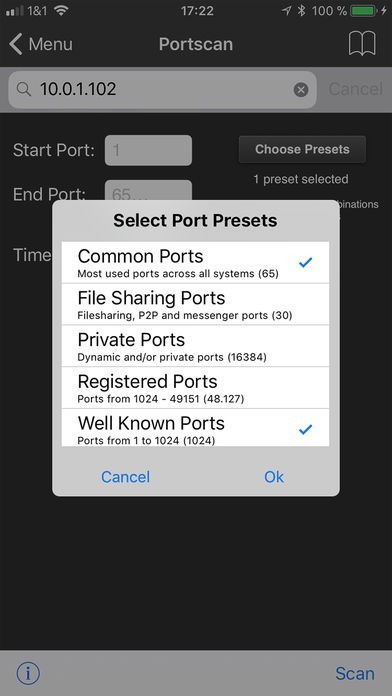

This enables quickly building fuzzing templates and sending them in a loop. The function fuzz() is able to change any default value that is not to be calculated (like checksums) by an object whose value is random and whose type is adapted to the field. Returns packets sent by send() > send ( IP ( dst = '127.0.0.1' ), return_packets = True ). > sendp ( rdpcap ( "/tmp/pcapfile" )) # tcpreplay. > sendp ( "I'm travelling on Ethernet", iface = "eth1", loop = 1, inter = 0.2 ). send() and sendp() will also return sent packet list if return_packets=True is passed as parameter. It’s up to you to choose the right interface and the right link layer protocol. The sendp() function will work at layer 2. That is to say, it will handle routing and layer 2 for you.

The send() function will send packets at layer 3.
Inet network scanner 2.4 how to#
Now that we know how to manipulate packets. Plots a lambda function applied to the packet listĭisplays a table according to a lambda function Returns a hexdump of packets with non-zero padding Returns a hexdump of packets with padding Returns a hexdump of the Raw layer of all packets Returns a packet list filtered with a lambda function > p = PacketList ( a ) > p > p = PacketList () > p ĭisplays a list of summaries of each packetĭisplays the preferred representation (usually nsummary()) On the other hand, it is possible to move sets of packets into a PacketList object, which provides some operations on lists of packets. In these cases, if you forgot to unroll your set of packets, only the first element of the list you forgot to generate will be used to assemble the packet. Some operations (like building the string from a packet) can’t work on a set of packets. > a = IP ( dst = ") > a > b = IP ( ttl = ) > b > c = TCP ( dport = ) > This implicitly defines a set of packets, generated using a kind of cartesian product between all the fields. Each field of the whole packet (ever layers) can be a set. Let see how to specify sets of packets as easily. Return a Scapy command that can generate the packetįor the moment, we have only generated one packet. Same as show but on the assembled packet (checksum is calculated, for instance)įills a format string with fields values of the packetĭraws a PostScript diagram with explained dissection psdump ( "/tmp/isakmp_pkt.eps", layer_shift = 1 ) If this is too verbose, the method hide_defaults() will delete every field that has the same value as the default: That’s because I consider that each field has its value imposed by the original string. We see that a dissected packet has all its fields filled. Identifying rogue DHCP servers on your LAN.Node status request (get NetbiosName from IP).How to use TCPSession to defragment TCP packets.This easy to use App outlines a computer n. INet Network Scanner 2.6.6 MAS macOS 101 mb iNet - explore your network! Find out about security risks and keep your network under control.
Inet network scanner 2.4 free#
The free multi-threaded SNMP, NetBIOS and IP scanner features a modern user interface that makes it easy to access its advanced features. SoftPerfect Network Scanner has an executable file that is launched directly from its stored location. INet is also available as iPhone and iPad app via the iTunes Store. Its very easy and user friendly design allows even the unexperienced user to get a profound and understandable overview of a network and the running services.
Inet network scanner 2.4 mac#
iNet Network Scanner provides you with information about networks your Mac is connected to.The iNet Network Scanner and Toolbox for. INet Network Scanner for Macintosh - Get a profound overview about your computer network with this easy to understand toolbox.


 0 kommentar(er)
0 kommentar(er)
